Two formidable exhibitions lie locked away, waiting to pour out their extraordinary contents that, at the beginning of this third millennium, certainly re-propose the structural arc of Mediterranean civilization as a perennial path of culture. The two exhibitions, that of Ulysses in Forli and that of Raphael in Rome, stand out as basic pillars for an immense epochal arc and pour out with stupendous masterpieces the themes of the human vicissitude.
We hope for their next opening and in the meantime we like to find among the anagogic scenes, which directly or virtually these Exhibitions expose, a particular thread that never disappears and which we can simply title “Man.” This word-idea contains in evidence all the possible human qualities and faculties, all the conditions and choices of existence, but in our meditation we want to pin on the male physical figure, on how it in art has summed up the mystery and the question of “who” is man, especially in the highest roles. Let us therefore see the male body: a body that must be naked! Indeed, it is statuary that has always dealt with manhood in the very intense, concentrated theme of a haughty, solemn presence. The Forli Exhibition offers us the ancient gods with a series of powerful, space-dominating subjects, while the Raphael Exhibition thrills us with an unspeakable Antinous and with Apollonian marble torsos, as well as with bronze statuary.
And we, first and foremost with Ulysses, plunge back into that Aegean aurora that saw the flourishing of youths in gymnasiums, the cult of energy and the strong dominance of male character in agonies, playful or warlike. First and foremost are the Greek gods, the first living in a human body, with human passions, and entangled in human destinies. Here they are from the Forlivian catalog: Jupiter, the Lord of Olympus, and Poseidon, the terrible god of the sea who will not cease for years to hurl Ulysses from island to island among the remotest. These are the gods, into whose breath the victorious ephebes of the games will want to enter, the kouroi, like the smiling boy of Volomandra, and like Aristodicus here oblatively taken as he advances toward the Nume, almost concentrating in the mighty buttocks theareté, the quintessence of the wills of the soul, which according to the belief of the time had its seat in the sacred bone. Antiquity has left us superb models of physicality expressed in the giving, in the liturgical protention of youth, laden with virtue, toward the celestials. And nudity is its total, fideistic, almost transhuman symbol, where no accessory is permissible, while only the hair and possibly the curls of the pubis (combed by the beloved maiden) mark consecration.
Then Greek art loved the body of adolescents.
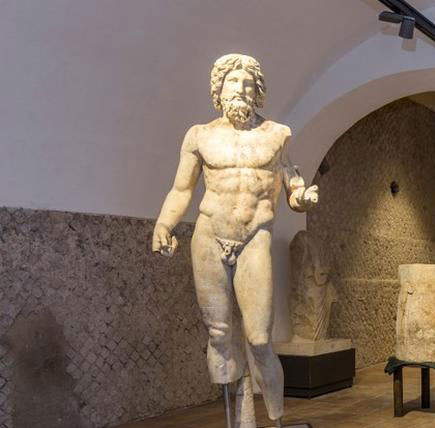 |
| Roman art, Jupiter (second half of 2nd to early 3rd century AD; white marble, 183 x 51 cm; Terracina, City Museum) |
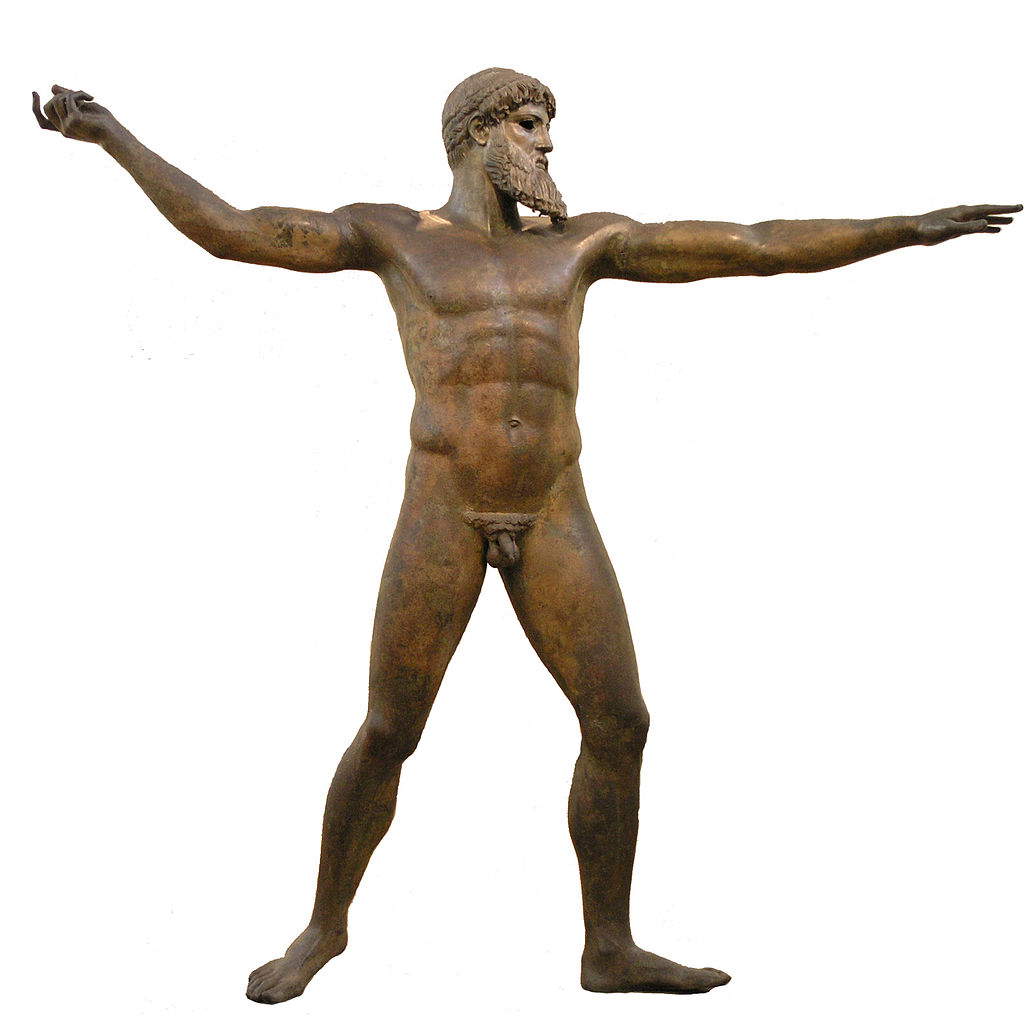 |
| Calamide or workshop of Calamide, Poseidon (480-470 BC; bronze, height 209 cm; Athens, National Archaeological Museum) |
 |
| Greek art, Kouros of Volomandra (560-540 BC; Paro marble, height 179 cm; Athens, National Archaeological Museum) |
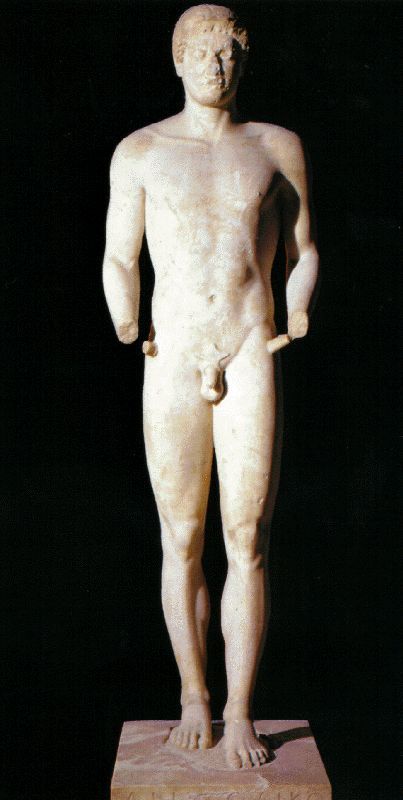 |
| Greek art, Kouros of Aristodicus (510-500 BC; Paros marble; Athens, National Archaeological Museum) |
In the early 16th century it is cogitative balance that responds to the ancient pylon, at the heart of the Renaissance. It is Raphael who responds to Greekness. The problem of the male protagonist, naked and standing, had passed through the Middle Ages with the improper and symbolic proofs of Pisano and Jacopo della Quercia, then into the humanistic ones of Nanni (admirable his Heracles in the sguguio), and the Christian ones of Brunelleschi and Ghiberti, and had resulted in the turned and stultifying enigma of Donatello’s David-Mercury. It will be Michelangelo who will face the challenge head-on, but Raphael well understands that it is balance, precisely, the courtly resolution, the sublime mixture vague in the Juliesque and Leonine humanism of the papal courts, when heroism yields to wisdom, to conscious order. Thus the Scuderie Exhibition offers us the classical recuperation, indebted above all to Hadrian and his voluptas, with the sinuous Torso of Apollo (the Sassi Torso) and with the very musical Antinous, of infinite sweetness, as feedbacks of a malicious acoustics that a remote echo repeats from the centuries.
Raphael collects, studies, takes up the ancient from the populous archaeological anthology that Rome offered him, and constantly distributes in his drawings and stage designs the truth of the structural human nude. On this aspect the Scuderie Exhibition is extraordinarily rich in drawings, fruitfully timely with each work, almost a continuous parallel treasure that remains masterful and invigorating. In this way the Urbinate always reveals himself as the ideal demiurge of the human body in every scene and every posture.
 |
| Nanni di Banco, Heracle (1404-1409; marble; Florence, Cathedral of Santa Maria del Fiore, Porta della Mandorla) |
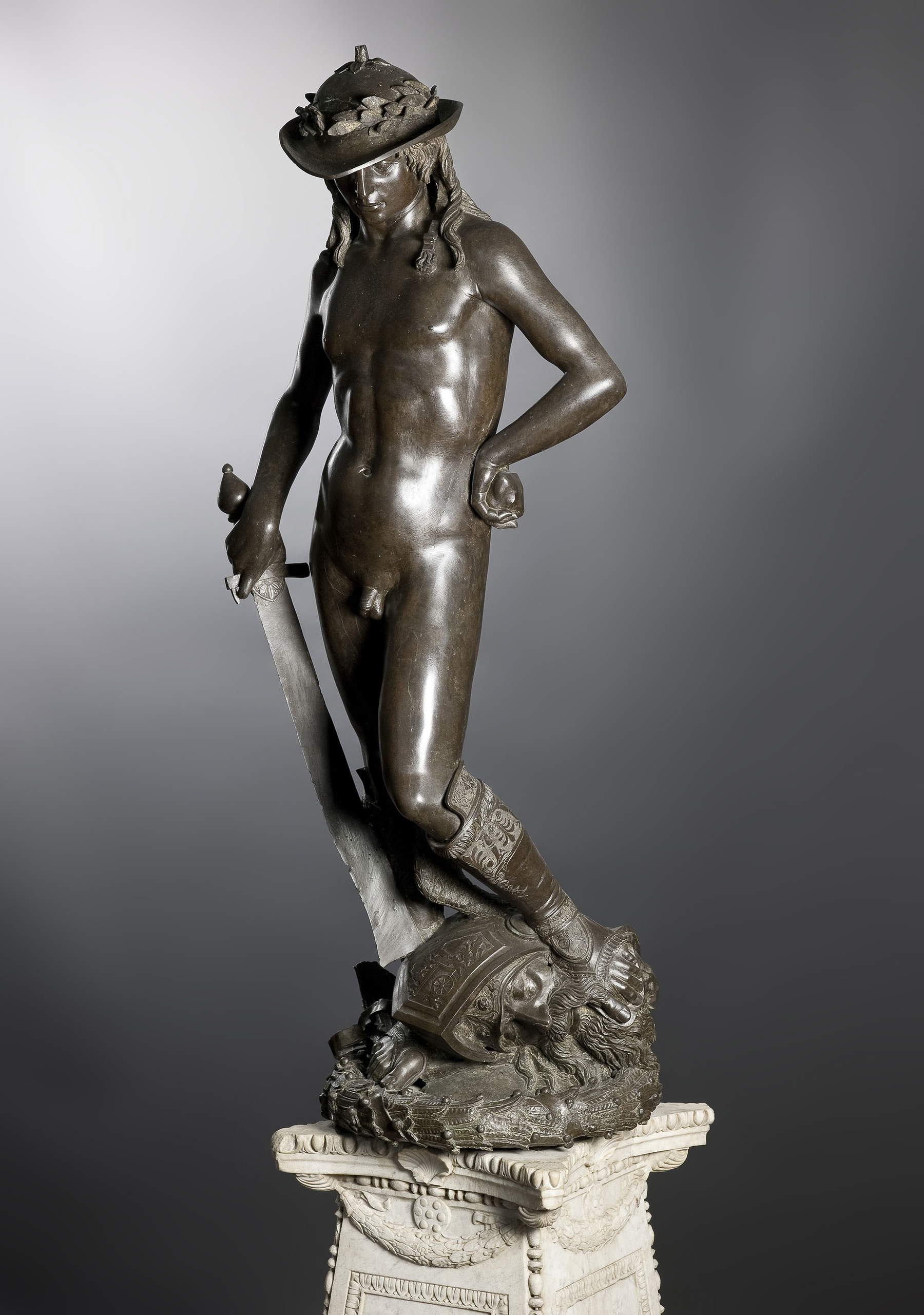 |
| Donatello, David-Mercury (c. 1440; bronze, height 158 cm; Florence, Museo Nazionale del Bargello) |
 |
| Roman art, Emperor Hadrian as Mars (2nd century AD; marble; Rome, Capitoline Museums) |
 |
| Roman art, Antinous (2nd century AD; marble, height 200 cm; Naples, National Archaeological Museum) |
But let us not forget Michelangelo’s challenge with thehapax of his young, gigantic and terrible marble David, placed coram populo in 1504, just the year of the young man’s arrival in Florence from Urbino. To that supreme nude we would like to say that Raphael responds by remaining himself, but certainly not in a disappointing way, on the contrary always presenting an impeccable and accomplished truth of unveiled reality. Along these lines we beg all future visitors to the Exhibition to keep a special attention to the drawings, and here we exhibit the Study for Mercury and Psyche from the Munich collection in which the figure of the god is a statuesque and perfect paradigm, without any doubt.
Finally, out of pungency and indebtedness to Michelangelo, we also note Leonardo’s secret study of Buonarroti’s colossus shortly after its placement in front of the Palazzo Vecchio, and how instead Correggio (1518) takes its creative force in the Oak-Crowned Hero, frescoed nude in the Monastic Chamber of St. Paul (also secret): almost the last legacy of Italian art to the eternal theme of kouros: strong, beautiful, and virtuous.
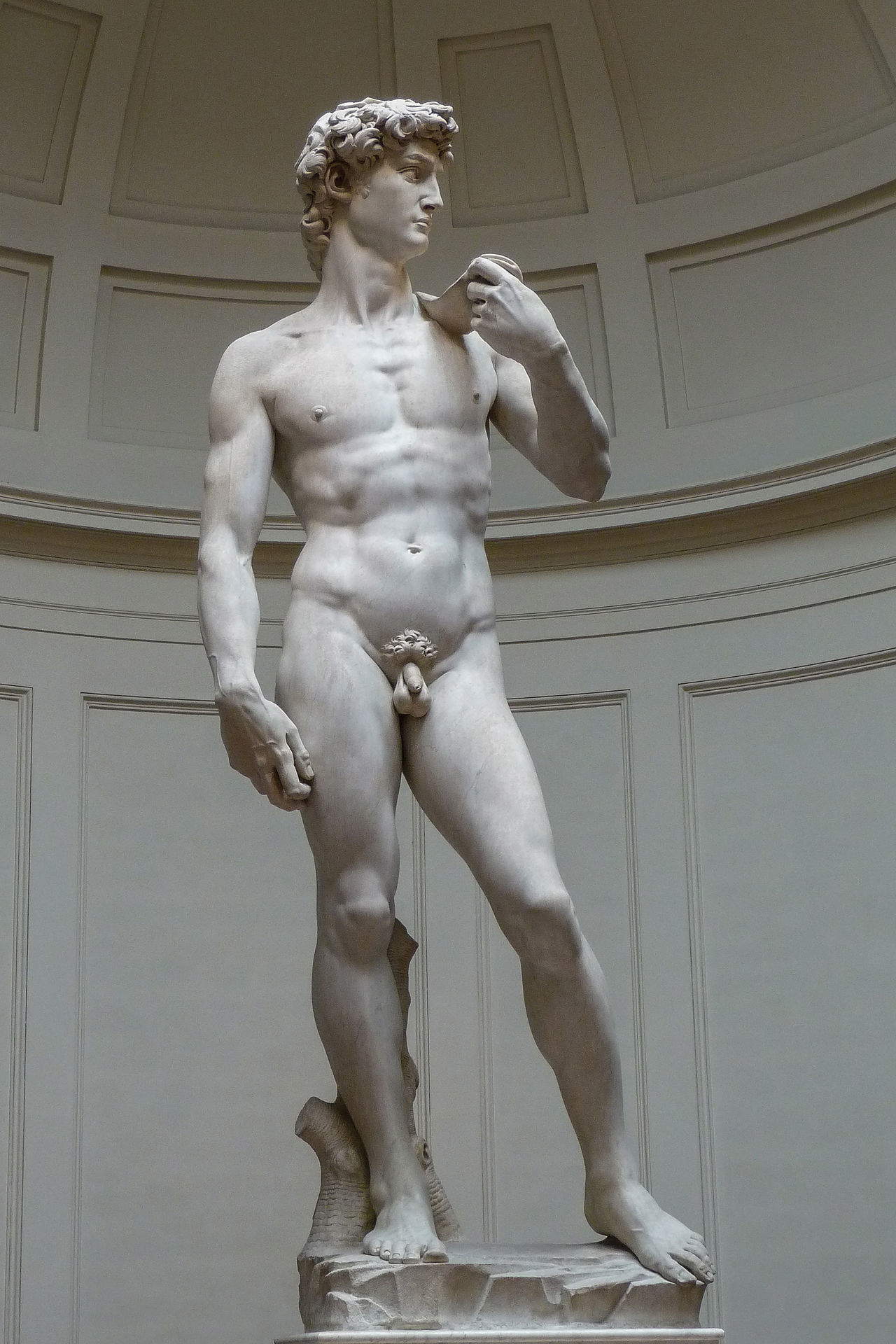 |
| Michelangelo Buonarroti, David (1501-1504; marble, 516 x 199 cm; Florence, Galleria dell’Accademia) |
 |
| Raphael, Study for Mercury and Psyche (1517; sanguine and pencil on paper, 269 x 227 mm; Munich, Staatliche Graphische Sammlung) |
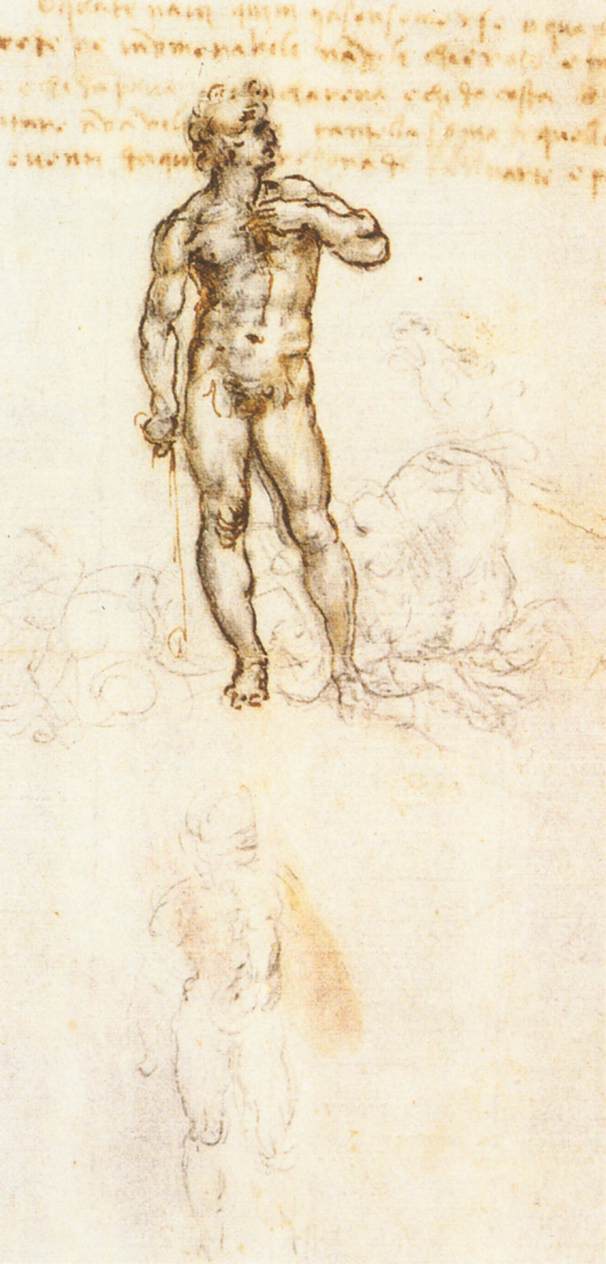 |
| Leonardo da Vinci, Study of Michelangelo’s David (1505; pen, ink and charcoal on paper; Windsor, Royal Collection) |
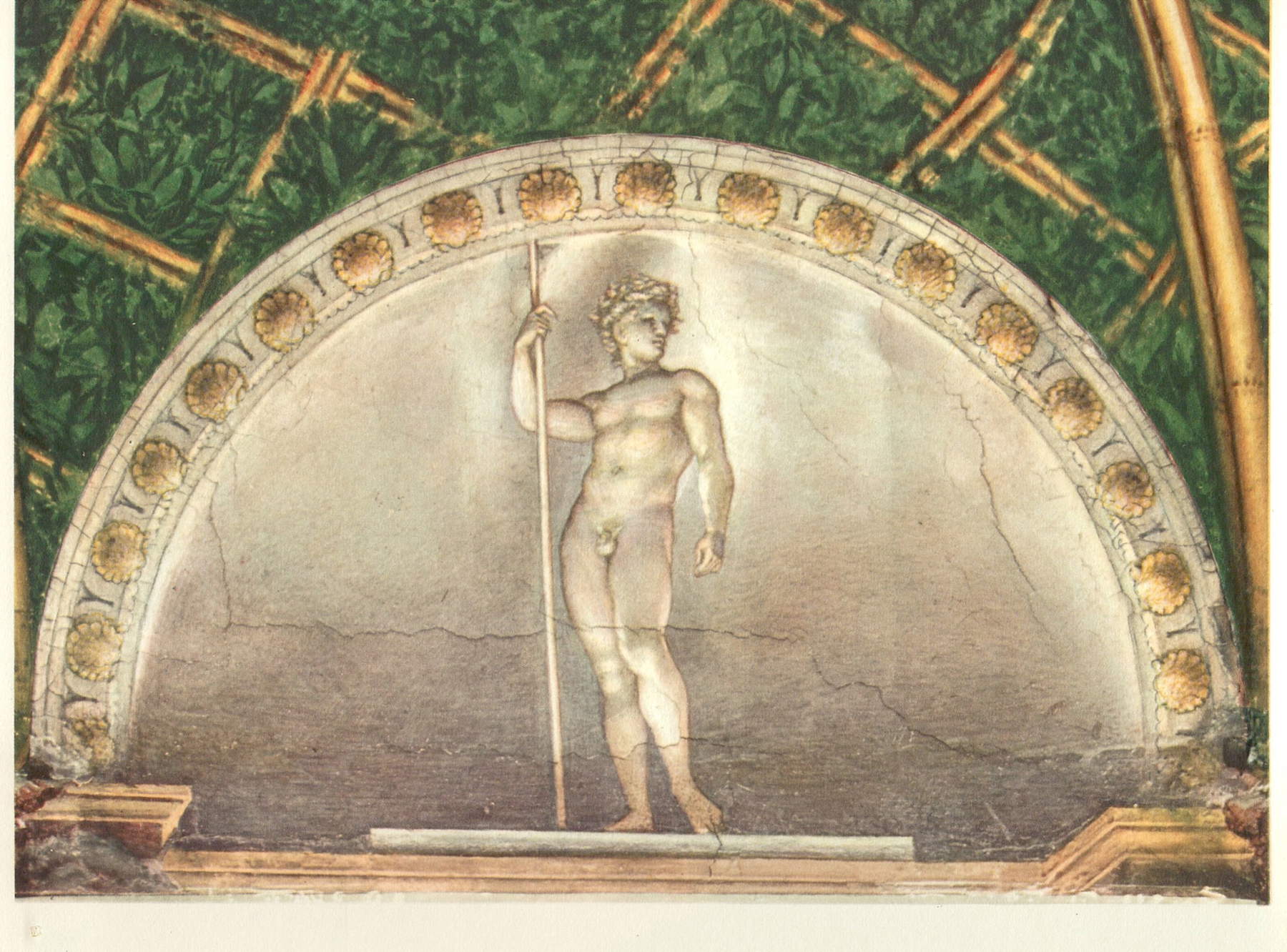 |
| Correggio’s Hero in the Camera di San Paolo in Parma (1518) |
Warning: the translation into English of the original Italian article was created using automatic tools. We undertake to review all articles, but we do not guarantee the total absence of inaccuracies in the translation due to the program. You can find the original by clicking on the ITA button. If you find any mistake,please contact us.